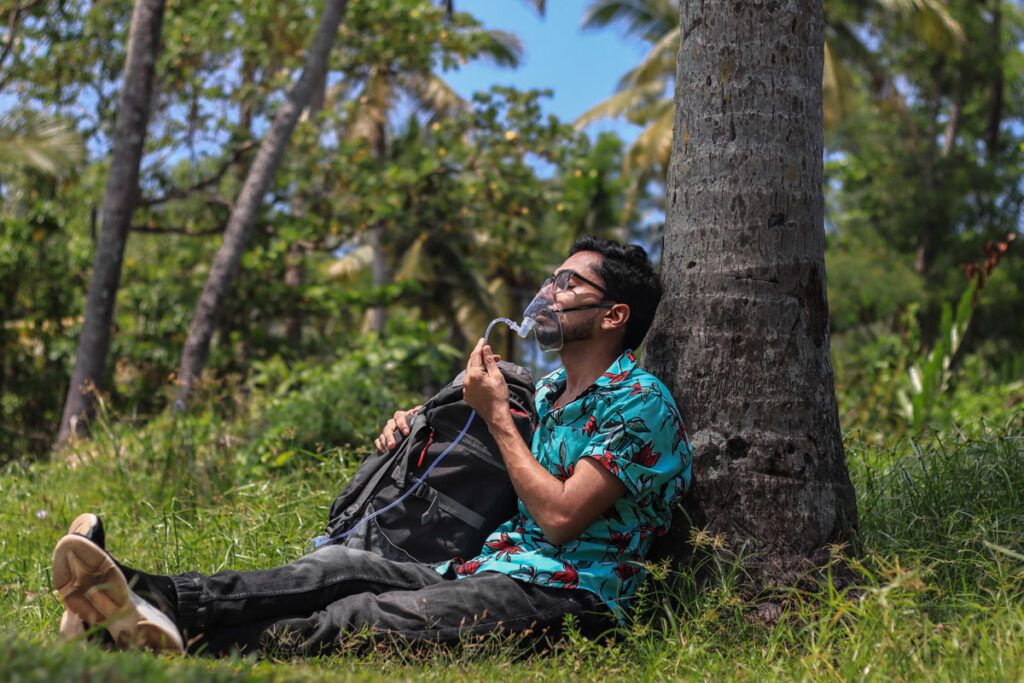COPD is a progressive condition that affects the lungs and makes it difficult for a person to breathe. Although there is no cure, there are many possible treatments, including oxygen therapy.
Oxygen therapy is a common treatment for COPD that can help manage your symptoms, particularly when combined with other treatments. Knowing more about the benefits and possible risks can help your doctor create a treatment plan that’s best for you.
What is oxygen therapy?

Oxygen therapy is a medical treatment that provides extra oxygen when your blood oxygen levels become too low.
This therapy helps deliver extra oxygen through devices like nasal cannulas (a tube that goes around your head with two prongs that sit just inside your nostrils), masks, or oxygen tents. By increasing the amount of oxygen in your lungs and bloodstream, oxygen therapy may improve your breathing and help relieve symptoms such as breathlessness related to conditions like COPD.
A doctor will determine the appropriate dosage and delivery method based on your needs and medical condition.
Benefits in COPD
Oxygen therapy can provide several benefits if you have COPD. A doctor will work out the specific amount of oxygen you may require and the best time to start oxygen therapy. This will depend on your needs and how serious your condition is.
Usually, a doctor will start giving oxygen therapy when your oxygen saturation level falls below a certain threshold, about 88% or below.
By delivering extra oxygen through devices like nasal cannulas or masks, oxygen therapy helps increase the amount of oxygen in your lungs and bloodstream.
The extra oxygen can improve your breathing and relieve symptoms like shortness of breath and fatigue. Oxygen therapy for COPD can also enhance your ability to perform daily activities and increase your exercise tolerance. Research has also shown that oxygen therapy can increase survival in people with COPD.
The amount of oxygen you receive is measured in liters per minute (LPM), indicating the flow rate of oxygen delivered to you. A doctor can determine the specific flow rate appropriate for you based on thorough assessments, including blood tests, lung function tests, and an evaluation of your symptoms.
Risks
While oxygen therapy benefits COPD, it is important to be aware of potential risks and side effects associated with its use. Risks in COPD may include:
- Oxygen toxicity: Receiving extra oxygen for an extended period can potentially lead to oxygen toxicity, which may cause lung damage and inflammation. Symptoms to look out for include headaches, dizziness, and fatigue.
- Skin and nasal irritation: Prolonged use of nasal cannulas or masks may cause skin irritation or pressure sores. Ensure your equipment fits properly, and discuss any discomfort or irritation with a doctor.
- Respiratory depression: In rare cases, high oxygen levels due to extra oxygen can suppress the drive to breathe during oxygen therapy, which means breathing gets slower and less effective.
Consider discussing any concerns or potential side effects with a doctor. They will be able to guide you in managing the risks associated with oxygen therapy while ensuring you receive the maximum benefits from oxygen therapy.
The main concern about oxygen therapy is that, despite being used for decades, research about it is still relatively limited, and it’s unknown how effective it is in treating COPD. However, if a doctor recommends it, it may still help your symptoms if used alongside other treatments.
Other treatments
Several medications are available for COPD. People with COPD can take these medications with the help of an inhaler:
- bronchodilators to relax and open the airways, such as albuterol or arformoterol (Brovana)
- corticosteroids to reduce airway inflammation, such as fluticasone (Xhance)
- combination medicines like Symbicort, which is a combination of budenoside (a steroid) and formoterol (a bronchodilator)
A doctor might also recommend pulmonary rehabilitation. This comprehensive program combines exercise training, breathing exercises, education, and counseling to improve your lung function, enhance exercise tolerance, and teach you techniques for managing COPD symptoms.
In severe COPD, doctors may recommend surgical treatments such as lung volume reduction surgery, which involves removing the damaged portions of the lung, or lung transplantation, which may be an option for people with end stage COPD.
However, the most suitable treatment option will depend on how serious your COPD is and your specific needs. Consider talking with a doctor, as they will help you create a personalized treatment approach that addresses your specific needs and goals.
If you need help covering the cost of medications, the free Optum Perks Discount Card could help you save up to 80% on prescription drugs. Follow the links on drug names for savings on that medication, or search for a specific drug here.
